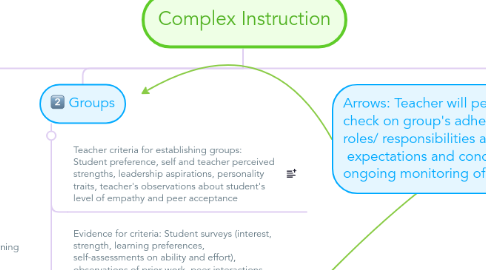
1. Organize
1.1. Teacher roles: Groups are created around a central theme with special attention paid to the unique roles to be assigned to members
1.2. Learner roles: Students communicate learning preferences, strengths, and potential contributions to multi-faceted projects
2. Groups
2.1. Teacher criteria for establishing groups: Student preference, self and teacher perceived strengths, leadership aspirations, personality traits, teacher's observations about student's level of empathy and peer acceptance
2.2. Evidence for criteria: Student surveys (interest, strength, learning preferences, self-assessments on ability and effort), observations of prior work, peer interactions, individual contributions to prior discussions, willingness to embrace leadership roles
2.3. Role Assignment: assigned according to individual strengths and preferences
2.3.1. Group Facilitator and Final Editor: Students this role will be comfortable with accepting responsbility for ensuring group members are on track, proof-reading final group submissions, and facilitating respectful discussions if disagreements or negative group dynamics arise
2.3.2. Final Editor: Responsibilities will include quality assurance of accuracy precision, and group buy-in for milestone assignments and final submissions
2.3.3. Researcher
2.3.4. Artist/Graphical Expert
2.4. Expectations
2.4.1. Group conduct expectations established at the beginning of year by teacher
2.4.2. Establishing group-based expectations are encouraged (model checklists provided for teacher to facilitate role expectations, deadlines, responsibilities for students who miss a class, etc...)
2.4.3. Suggestions for steps toward mediation will be provided for groups who are dissatisfied with the collective work dynamics

